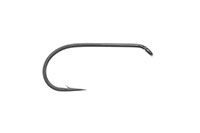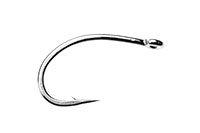
Mountain Streams --Vol.11--
Refreshing Lunn's Particular
My fly fishing began with dry fly fishing, so my fly tying also began with the dry fly. At first I tied the hackle fly, a similar type to what was often used for Japanese traditional fly fishing. Then getting accustomed to fly tying, I tied the winged fly. When my stocks of fly materials got extremely larger than in my early days, I tried to tie any fly in my pattern books just to satisfy my curiosity. My attempt to tie unknown patterns according to the pattern list started in those days. I tied nearly 300 patterns in a few months. I enjoyed tying very much and I was excited to feel that I could take a glimpse of the profound world of fly fishing, although my dream of creative tying, that is, tying the original pattern was completely shattered.
My fly box filled with spinners.
Two of them which rest their wings outside are Lunn's Particular and Yellow Boy.
Two of them which rest their wings outside are Lunn's Particular and Yellow Boy.
For rather long period in my practice of dry fly tying I had spent all my energy in keeping the fly floating on the water surface. Then one day I found that too much buoyancy was annoying me. Actually, both no floating and too much floating were troublesome. Floating well just on the water surface was ideal. Where is such a fly? I picked up some flies from the list I had already tied. Those flies had something to draw my attention and all were mayflies with spent wing.
As for the mayfly both spent wing pattern and fan wing pattern have long known well. I tied both types and dashed to float them on the river. But I did not get good results. No-hackle pattern sank in a moment. Fan wing pattern could float relatively well but it was too large to use every day.

Lunn's Particular showed surprisingly great power in both Okutama and the Katsura River.
Then I tested the fly with spent wing made of hackle tip. It got good results. Above all it was pretty. First I tied spinner of March Brown named Great Red Spinner. I was really surprised and satisfied that it could float well and fish came up well to it. The only trouble was that its well buoyancy did not last long.
Next I used Lunn's Particular, which had long drawn my attention. It utterly shocked me. It floated perfectly and fish came up to it unbelievably well. I could see it very clearly as long as the weather was fine.

Lunn's Particular
Furthermore, to my surprise, it still floated after it caught more than 5 fish. A bit of a worry was that there was an unconvincing point in body tying. The pattern book suggested using hackle stalk of Rhode Island Red. I guessed it should be wound as the body. I plucked hackle fibres but that resulted in peeling the fine brown surface from the stalk. Giving up plucking them, I cut off patiently all the fibres at the base with scissors. However, when I wound that stalk, I found the fibres that I thought had been cut off were standing up like a hairy caterpillar. Then I had to cut them off with cutter knife, spending a lot of time. It sounds ridiculous today but I needed some time to realize that I should use the wrong side of hackle stalk. I had still no confidence of my guess until I met John Veniard in 1974, who assured me that my guess was correct. I remember feeling relieved to hear that.
Olive in the Katsura River
I was very pleased to add Lunn's Particular in my fly box because for some reason I liked flies made by William J. Lunn, a river keeper of the River Test in England. After I mastered how to tie Lunn's Particular, I began to tie a lot of his patterns, such as Houghton Ruby and Yellow Boy, famous flies in the history. Gradually I became fascinated by charm and magic of spinners.In those days I went without hesitation to the Oshino River near Mt. Fuji in March, the opening season. I often spent daytime in the Katsura River downstream. The water temperature was so high there that yamame trout frequently made rise near noon even in early March. But it was not easy to catch them in spite of frequent rise. I could catch a few with any fly but the catch was far from sufficient level for their rise. Those spinners, however, completely changed the situation. The number of fish that came up to those spinners and also took the hook increased dramatically. Clearly that was due to changing the fly into spinners.

Spent Badger tied by me about 1975
Summer Char in the Kimpusan River
In early summer I started char fishing as usual. Through frequent visit for several years I knew well about the Kimpusan River, the main stream of the Chikuma River and other tributaries. My task there was how to fish low water. There were definitely some fish but they did not respond well. When I drifted the fly in a large pool, one or two fish responded quickly and jumped at the fly firmly, while the rest of fish only turned their body under the fly or came up halfway to the fly and returned. How can I awake those fish? I looked for eagerly which fly had those factors that could awake the fish; red or white colour, lustre of peacock, floating just on the water surface. I tested one fly after another but could find no fly with all those factors.
Since the latter half of 1970's many yamame trout have taken Spent Badger in its mouth in my photos.

Spent Badgers with V-cut Hackles.
If there is no ideal fly I will surely devise one. The base colour should be white because white colour excites fish. But a solid-white fly will look like White Miller, so I will also have the black inside in order to get clear silhouette when it is seen from under the water. So white tip of the fly will not be seen clearly. Then a little longer hackle will cause no problem. That will also be convenient to have a long tail that assures well buoyancy. For this reason I chose badger colour for hackles and tail. The body should be exciting colour to fish. Actually I chose red-dyed hackle stalk because it is strong, well buoyant and keeps its colour even if it is wet. The wing should be white like hackles. In order to make the fly float just on the water surface, the wing should be spent wing made of hackles. Since white hackle tip of hen is easier to get than that of cock, the wing will be made out of hen neck.
In that way, I completed a new fly and went to the Chikuma River with it. Fortunately, I got much more remarkable results than I had expected. Fish came up to it extraordinarily enthusiastic. It looked as if fish had provoked a fight with the fly. That was why it was often called Crazy Badger in the beginning, instead of Spent Badger.
During my 20 years' practice of dry fly fishing--- in 1970's I exclusively devoted myself into dry fly fishing and since then have enjoyed it in mountain streams--- Spent Badger caught the largest number of fish among all my flies. When I completed it I had not got the slightest idea that Spent Badger was going to make such good performance. At that time I was still green to know how mysterious the fly really was.
-- To be continued --
- NET SHOP INFORMATION

SL6 Black Spey Hooks

DU3 Limerick Spinner Hooks

SL4 Single Bartleet Hooks

XD1 Tube Fly Double Hooks

DD2 Flat Perfect Hooks

DD1 Black Terrestrial Hooks

TD4 Old Limerick Wet Hooks

DU1 Silver May Hooks

MU1 Flat Midge Hooks

LD3 Long Limerick Hooks

TD2 Summer Sproat Hooks

XS1 Tube Single Silver Hooks

TD6 Siver Sedge Hooks

SL5 Black Spey Hooks

DU3 Limerick Spinner Hooks
- TROPHY CLUB
- FLY SHOW
- EXHIBITION
- MASTERS`
- FLY DRESSING CONTEST Archives
- TRAVELLER Archives
- TACKLE IMPRESSIONS Archives
- ANGLERS` PHOTO GALLERY Archives
- ----------------------------------------------
- トロフィークラブ
- フライショー
- エキシビション
- マスターズ
- フライドレッシング・コンテスト・アーカイヴ
- トラヴェラー・アーカイヴ
- タックル・インプレッション・アーカイヴ
- アングラーズ・フォトギャラリー・アーカイヴ
株式会社サワダ 185-0021 東京都国分寺市南町3-13-4
SAWADA'S INC. 3-13-4 Minamicho, Kokubunji, Tokyo 185-0021, Japan
写真・ドキュメントの無断転載を禁じます。
All the images and documents found on this site are owned by Ken Sawada and may not be used without permission.
But, link to this site is FREE.
Copyright © 2000 - 2024 SAWADA'S INC.. All rights reserved.
SAWADA'S INC. 3-13-4 Minamicho, Kokubunji, Tokyo 185-0021, Japan
写真・ドキュメントの無断転載を禁じます。
All the images and documents found on this site are owned by Ken Sawada and may not be used without permission.
But, link to this site is FREE.
Copyright © 2000 - 2024 SAWADA'S INC.. All rights reserved.
